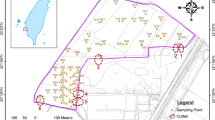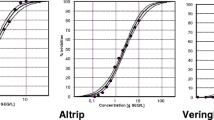Abstract
The fate of TCDD (2,3,7,8-tetrachlorodibenzo-p-dioxin) was studied by using aquatic sediment and lake water under laboratory conditions. Most of the TCDD was found in the sediment from which it slowly disappeared. Evaporation may be a major mode of disappearance of TCDD in samples incubated 39 days or more, with metabolism playing only a minor role. Under the experimental conditions the half-life of TCDD was in the order of 600 days. The metabolic activities were enhanced under conditions which stimulated microbial growth in the presence of sediment, and the metabolites were found to be released from the sediment to the ambient water.
Similar content being viewed by others
References
Clark, J. M.: Metabolism of toxaphene by aquatic sediments and a camphor-degrading Pseudomonad. M. S. Thesis, Department of Entomology, University of Wisconsin-Madison (1976).
Crosby, D. G., A. S. Wong, J. R. Plimmer, and E. A. Woolson: Photodecomposition of chlorinated dibenzo-p-dioxins. Science173, 748 (1971).
Crosby, D. G., and A. S. Wong: Environmental degradation of 2,3,7,8-tetrachlorodibenzo-p-dioxin (TCDD). Science195, 1337 (1977).
Helling, C. S.: Pesticide mobility in soils II. Applications of soil thin-layer chromatography. Soil Sci. Soc. Amer. Proc.35, 737 (1970).
Isensee, A. R., and G. E. Jones: Absorbtion and translocation of root and foliage applied 2,4-dichlorophenol, 2,7-dichlorodibenzo-p-dioxin, and 2,3,7,8-tetrachlorodibenzo-p-dioxin. J. Agr. Food Chem.19, 1210 (1971).
Isensee, A. R., and G. E. Jones: Distribution of 2,3,7,8-tetrachlorodibenzo-p-dioxin (TCDD) in an aquatic ecosystem. Environ. Sci. Technol.9 (7), 667 (1975).
Kearney, P. C., E. A. Woolson, A. R. Isensee, and C. S. Helling: Tetrachlorodibenzodioxin in the environment: sources, fate and decontamination. Environ. Health Perspectives5, 273 (1973).
Matsumura, F., and H. Benezet: Studies on the bioaccumulation and microbial degradation of 2,3,7,8-tetrachlorodibenzo-p-dioxin. Environ. Health Perspectives5, 253 (1973).
Neubert, D., P. Zens, A. Rothenwallner, and H. J. Merker: A survey of the embryotoxic effects of TCDD in mammalian species. Environ. Health Perspectives5, 67 (1973).
Schwetz, B. A., J. M. Norris, G. L. Sparschu, V. K. Rowe, P. J. Gehring, J. L. Emerson, and C. G. Gerbig: Toxicology of chlorinated dibenzo-p-dioxins. Environ. Health Perspectives5, 87 (1973).
Author information
Authors and Affiliations
Rights and permissions
About this article
Cite this article
Ward, C.T., Matsumura, F. Fate of 2,3,7,8-tetrachlorodibenzo-p-dioxin (TCDD) in a model aquatic environment. Arch. Environ. Contam. Toxicol. 7, 349–357 (1978). https://doi.org/10.1007/BF02332062
Received:
Accepted:
Issue Date:
DOI: https://doi.org/10.1007/BF02332062




